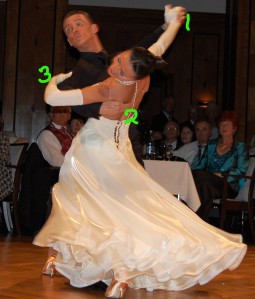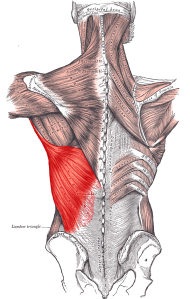If you’ve been in the ballroom dance world, even for just a short time, you’ve probably heard someone talk about frame. Frame describes how a dancer holds their arms, stands, and physically connects to their partner. It enables the partnership to move as one unit with a common center-the dream!
 Points of connection are:
Points of connection are:
- The leader’s left palm to the follower’s right palm
- The leader’s right palm to the lateral portion of the follower’s left scapula (furthest from the spine)
- The follower’s left hand below the leader’s right bicep
- The follower’s left upper arm to the leader’s right forearm
- The leader’s right torso to the follower’s right torso when in body contact
- Visual connection
A partnership unquestionably uses connections one through five for standard dancing, in which the leader and follower never leave frame. However, smooth, latin, and rhythm dancing also incorporate the sixth form of connection: visual. Take chase in cha cha, for example. The lead and follow have dropped physical contact. How does the follow know to perform a switch turn or to return to the lead? Okay, it could be choreographed but more likely (and even then) it’s because the follow is watching the lead for visual cues.
 Toned (not tense) lats. Let your arms drop to your sides and now raise them in front of you as if you were hugging a beach ball (a porte de bras from fifth en bas to first for the ballet dancers). This simple action should engage your lats or latissimus dorsi muscles, whose origins are the sacral, lumbar, and first six thoracic vertebrae. The muscle inserts at the humerus, more specifically the bicipital groove. In other words, the lats help to connect your trunk to your arms and frame!
Toned (not tense) lats. Let your arms drop to your sides and now raise them in front of you as if you were hugging a beach ball (a porte de bras from fifth en bas to first for the ballet dancers). This simple action should engage your lats or latissimus dorsi muscles, whose origins are the sacral, lumbar, and first six thoracic vertebrae. The muscle inserts at the humerus, more specifically the bicipital groove. In other words, the lats help to connect your trunk to your arms and frame!
Note: Your shoulders should rest on top of this as if they were hanging on a coat hanger-positioned backward and downward.- An isometric stretch from elbow to elbow. Imagine that you have a rubber band connecting one elbow to the other. You don’t want to collapse your elbows in toward the center of your body, but rather gently stretch outward, against the rubber band but not breaking it.
Note: You could tie the ends of a theraband to each elbow to learn this feeling! - Keep your elbows in sight. It’s tempting to draw the elbows back into a straight line. However, this projects the chest forward into your partner’s space and it’s uncomfortable! You should be able to glimpse your elbows out of the corner of your eyes when looking straight ahead.
- Maintain proper posture. Posture will get its own dedicated post as there’s a lot to say here. For now, let’s sum it up as stand up straight with your weight on the balls of your feet and the lower front of the rib cage tucked in.